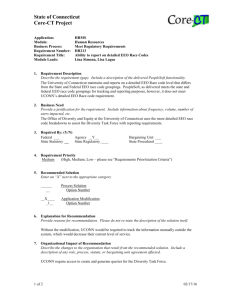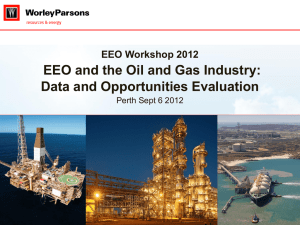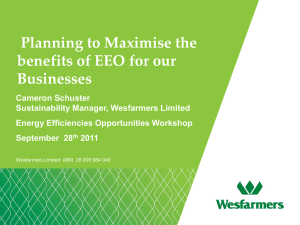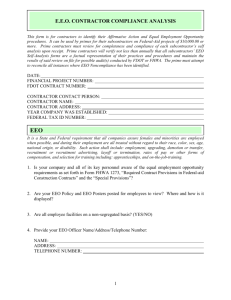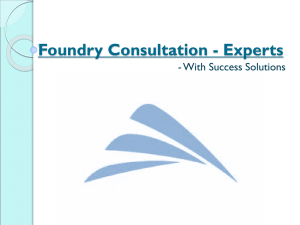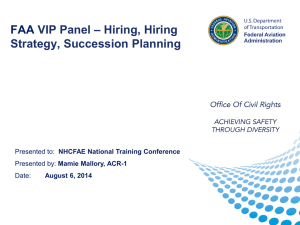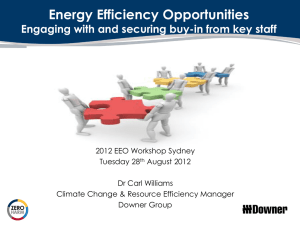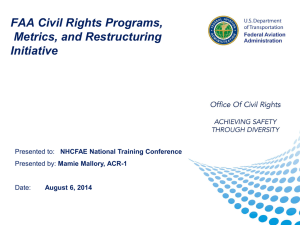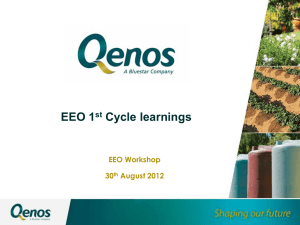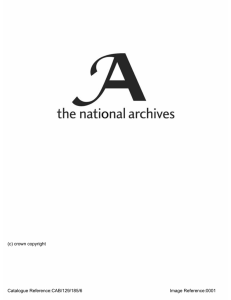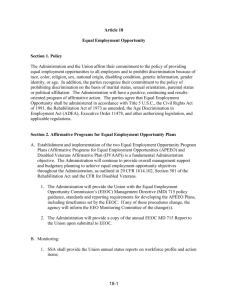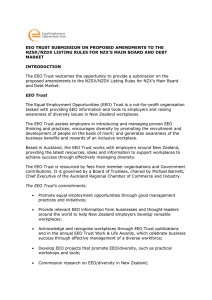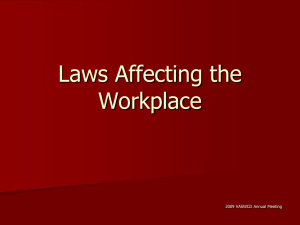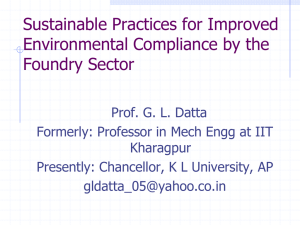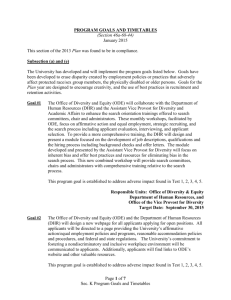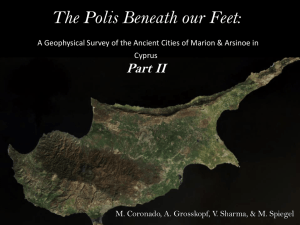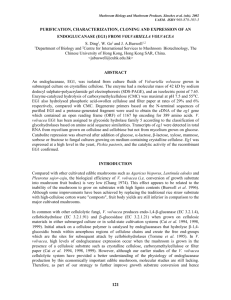Bradken Presentation 2013 - Energy Efficiency Opportunities
advertisement
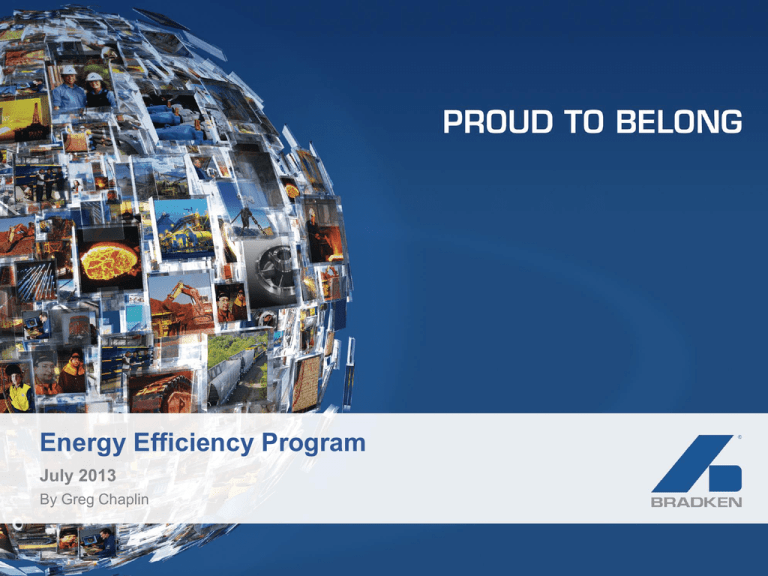
Energy Efficiency Program July 2013 By Greg Chaplin Bradken Overview • Bradken® is a leading global manufacturer and supplier of differentiated consumable and capital products to the mining and construction, rail and transit, energy and general industrial markets • As a leading heavy engineering company, Bradken can manufacture fully machined cast iron and steel products from a mass of 0.5kg to over 25 tonnes • Bradken is a publicly listed Company on the Australian Stock Exchange (BKN) • Founded in 1922 in Alexandria, Sydney (AUS) – Leslie Bradford & Jim Kendall won money on a horse “Jack Findlay” and used the winnings to establish Alloy Steel Syndicate to build the foundry. • Global Corporate Centre located in Newcastle, NSW (AUS) ©2011BRADKEN® Bradken – Environmental Basics • All Bradken’s major facilities in Australia & UK are independently certified to ISO14001, other sites at implementation stage. • Bradken’s steel foundries account for 90% of the Company’s total energy usage • Electricity ~ 60% and Natural Gas ~ 40% • Australian energy use ~ 1.15 Peta Joule & 139,300 t CO2e • Australian energy costs ~ 5-8% of costs • Approximately 92% of all cast products are produced from scrap steel • Product Stewardship – Buy Back Scheme • Foundry sand used up to 10 times • Used foundry sand often used by other industries (beneficial reuse) ©2011BRADKEN® Foundry Processes Bradken foundries use a range of modern technologies including: • • • • • • • • ©2011BRADKEN® CAD/CAM 3D Modelling Discrete Element Modelling Dynamic Simulation Analysis Finite Element Analysis Virtual Prototyping Casting simulation Robotic Manufacturing EEO First Round • Bradken identified it used more than 0.5 PJ, registered and submitted the assessment plan • Bradken used four separate energy consultants to audit seven of its foundries with the intention of ending up with four different sets of recommendations. Overall, the ideas were very similar: • Savings in GJ and tons CO2e identified were very similar between auditors • Upgrade cost estimates varied significantly (up to a factor of five) • Savings of 10-17% in GJ and costs were identified ©2011BRADKEN® Factors affecting first round • Age of equipment • Retrofitting costs & difficulty • Training & awareness • Accuracy of estimates • Sub metering • GFC • Company growth • International competition & Value of the Australian dollar • Productivity, quality and safety improvements • Environmental demands - NIMBY ©2011BRADKEN® Bradken Growth - 2006 to 2013 Bradken has experienced significant growth through: • The acquisition of existing foundries in the Australia, UK, USA, Canada, Malaya and New Zealand • New fabrication facilities in China • Commissioning new foundry in China Production Employees Revenue Foundries - Australia Foundries - International ©2011BRADKEN® 2006 2012 56,000 t 147,600 t 2500 6250 $548 M $1,451 M 7 9 1 10 Energy Performance overall GJ/t - Australia • ©2011BRADKEN® Changes in overall energy use per tonne of product EEO Round 2 - Key Element 1 & 2 – Leadership & People For the second round of EEO audits Bradken has: • Updated Environmental Policy in 2011 • Added Energy & GHG Policy in 2011 • Updated Corporate Environmental Goals to include specific goal to reduce energy use per ton of product by 2% per year. – Consistent with UK Climate Change Agreement – US sites set goal at 2.5% - US DoE “Better Buildings, Better Plants Program” • Utilised internal and external resources to develop internal knowledge, awareness and skills. ©2011BRADKEN® EEO Round 2 – Key Elements 3 & 4 - Assessment & Identification • Internal audits where practical – combine energy, raw material & waste audits • Developed own checklists & utilise US DoE tools • Purchased thermal image cameras, flue gas analysers, compressed air leak detection equipment for internal use • Update previous audits with better monitoring • Utilise extensive publicly available information from – US DoE & AFS - various – UK Carbon Trust & DEFRA & CTI - various – Environment Canada - various – European Commission “Best Available Techniques in the Smitheries and Foundries Industry” • Bring in external specialist consultants eg. arc furnace specialists (July 2012) where needed • Benchmarking across Bradken’s 19 foundries ©2011BRADKEN® EEO Round 2 – Key Elements 3 & 4 – DATA INTERNATIONAL COSTS ©2011BRADKEN® EEO Round 2 – Key Elements 3 & 4 – DATA BENCHMARKING ©2011BRADKEN® EEO Round 2 – Key Elements 3 & 4 – DATA - GAS • Gas use ~40 % of total GJ - 80 to 93% in heat treatment • Heat Treatment has specific quality requirements – heat castings to specific temperatures for specific amounts of time. • Thermal imagery used to identify hot spots. • New ovens 30% more efficient with recuperative burners & pulse firing than same sized oven with conventional burners & controls ©2011BRADKEN® EEO Round 2 – Key Elements 3 & 4 – DATA - GAS • Ladle Heaters use 7 to 20% of site gas • Heated to as hot as practical to carry molten metal from furnace to moulds and pour metal into moulds. • “State of the art” – oxy fuel burners – up to 50% gas savings (ref FOUNDRYBENCH – Europe) – one installed OS that demonstrates these savings. ©2011BRADKEN® EEO Round 2 –– DATA - Electricity • Equipment Electricity use ©2011BRADKEN® EEO Round 2 – DATA - Furnaces • Melting Furnace Efficiency Factors – – – – ©2011BRADKEN® Operators, Tap to tap times Furnace size, Alloys, Scrap Quality Age of furnaces - 1930s to 1990s “Furnace Whisperer” EEO Round 2 – Key Elements 3 & 4 – DATA Furnaces • • • Different steel alloys have different melting efficiencies Product design affects Yield Starting from cold - 20% extra ©2011BRADKEN® EEO Round 2 – DATA – Compressed Air • Compressed electricity use while compressed air leaks are fixed. ©2011BRADKEN® Factors Affecting Decisions • New foundry in China • Sub metering • International Competition • Clean Technology Food & Foundry Program – 33% – Sub metering & power factor • US Funding – Tacoma Compressed Air Project – Cost $765k – Incentive $536k => 70% – Annual Saving $130k and 3,148,285 KWh • Energy Costs and Carbon Tax ©2011BRADKEN® Carbon Tax • UK Carbon Tax – Tax on electricity offset by Climate Change Agreement (reduce energy use per ton by 2% per year) – Low CO2e t/KWhr factor – Low impact – (site managers) – changes may come • New Zealand Carbon Tax – Increase in LPG costs – Not detectable in electricity - low CO2e t/KWhr factor • Australian Carbon tax (plus transmission charges) – Estimated $3.5 million – To date price rises for electricity 8 to 34% – LRECs, SRECs also a carbon tax – July 2014 ??? ©2011BRADKEN® EEO Round 2 – KE 6 - Communicating Outcomes Bradken Eco-Efficiency Games - 2012 • Bradken benchmarked all 18 steel foundries KPIs against each other and ranked performances • KPIs were: – Energy => GJ/t, $/t, GHG/t – Key resources => t/t (scrap metal, alloys, sands, water, manhours/t) – Waste => t/t, $/t product, $/t waste • Gave overall performance levels and winners were: • GOLD MEDAL => Adelaide, SA • SILVER MEDAL => Mont Joli – Quebec, Canada • BRONZE MEDAL => Henderson, WA USE LESS, WASTE LESS, COST LESS ©2011BRADKEN® USE LESS, WASTE LESS, COST LESS • THOSE WHO DO NOT LEARN FROM HISTORY ARE DOOMED TO REPEAT IT (??) • DO NOT RE-INVENT THE WHEEL • BENCHMARKING • TRAINING & AWARENESS ©2011BRADKEN®
